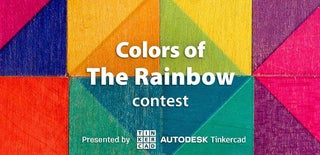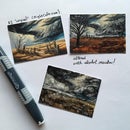Introduction: Six Art Projects That Celebrate COLOR
I am the host of a weekly “open studio” at the Topeka Art Guild. Here are some projects that are encourage a wild and wonderful exploration of color. They are suitable for artists of ALL ages.
Step 1: Project #1: Gel Plate Printing
Materials: Gel plate, acrylic paint, textured items, 2 or more rollers, paper
A method for beginners:
1. Cut out three simple shapes that will fit within the space available on the gel plate.
2. Place two colors of paint on the gel plate. (NOTE: It does NOT take a lot of paint!) Lightly move the roller to spread the paint. The best method is to roll and lift, in several directions, until the paint is smooth. How much mixing you do depends upon the “look” that you want!
3. Place one or more textured items on the plate. Press lightly. Remove.
4. Place the cutout shapes in the desired arrangement.
5. Place paper over the plate. Roll with a second (clean) roller.
6. Remove the paper. The shapes may or may not become attached to the paper. If they do, use a pin to carefully remove them.
Step 2: Project #2 Alcohol Ink on Glass
Materials: Ceramic tiles, alcohol ink, optional: blower of some type optional: clear acrylic spray paint
This is easy but SO much fun. Drip alcohol ink onto the tile. If desired, tilt the tile, or blow the ink, or use a brush. Alcohol ink works best on NONPOROUS materials, such as tile and glass. The end product is not what is important in this project. It’s the FUN of watching the brilliant colors mix and flow. Seriously: this project has a lot of WOW POWER!
Inks can easily be chipped or rubbed off. A drop of anything alcohol-based will re-activate the inks, so a couple of coats of clear acrylic spray paint are recommended.
ADDITIONAL IDEAS: You can also do this project on glass, while it is still in the frame. The reverse can safely be displayed without any kind of sealer.
Step 3: Project #3: Magic Duplicating Gel
I’ve published the instructions for this project before (https://www.instructables.com/Grandma-Vans-Magic-Duplicating-Gel/), but it really BELONGS in this set of “Projects that Celebrate Color.”
This project is particularly great for very young children. They will make drawing after drawing, just to see the magic each time they open up the folded paper.
Step 4: Project #4: Acrylic Painting
Materials: Mini canvas-easel combination, acrylic paint, brushes, plastic scraps for palettes
Painting is fun for artists of ALL ages. It is possible to find combination sets of small canvases and easels for a very reasonable price. These are perfect for beginners.
While the art teacher inside of me wishes that every person will come into the classroom with their own original ideas for what-to-paint, the reality is that most people need a little help to get started. There are many tutorials online, but it’s good to have a few projects ready to teach step-by-step.
Here’s one that teaches some of the basic principles of working with acrylics… but it still leaves room for originality. Most of all: It’s fun! (See the video for better instructions.)
- Mix blue and white to get a medium light blue. Paint across the top third of the canvas. Be sure to include the top and sides.
- Mix a slightly darker blue. With VERTICAL strokes, paint across the canvas, slightly overlapping the previous layer, to form mountains.
- Mix a darker blue, and this time, don’t mix fully. Allow white streaks to remain. Paint the next layer of mountains.
- Mix a blue similar to that used for the sky, but again don’t mix it fully. We want some white streaks. With horizontal strokes, paint the water.
- If possible, allow to dry. If not possible, work carefully. Use full-strength blue paint to add rocks.
- Allow to dry. Add white ripples on the water and a white moon in the sky.
Step 5: Project #5: Mulberry Paper Colláge
Materials: Mulberry paper, gloss or matte acrylic medium, heavy paper, optional: scissors
Mulberry paper can be cut, but I find tearing it gives better results. The method I prefer is to use acrylic medium as both glue and varnish.
Apply a layer of medium, place a piece of mulberry paper on top. Paint a layer of medium over the top. Continue adding layers of torn mulberry paper. A very relaxing project! Take your time and enjoy smoothing down each lovely little piece of paper!
Step 6: Project #6: Alcohol Marker on Yupo
Materials: Yupo ATC sheets, alcohol markers, optional: rubbing alcohol, dried up markers or Q-tips or fine brushes.
Alcohol markers have a very distinctive look when used on Yupo. I buy little 3.75” x 2.5” tablets of Yupo for this project. (Larger sheets are a little expensive when you are donating all the materials for a group activity!)
It is best to have a few examples to show students what to expect when using these markers: The ink will not absorb into the Yupo. When one color is applied over another, the new layer of wet ink will reactivate the lower layer, giving you a “bloom” similar to that you find with watercolor.
You may also want to demonstrate the method of “subtracting” color from the Yupo, using a colorless blending marker or a Q-tip dipped in alcohol or a fine brush dipped in alcohol. Note that the markers WILL stain the Yupo, so you will never be an able to subtract to a pure white.

Participated in the
Colors of the Rainbow Contest













